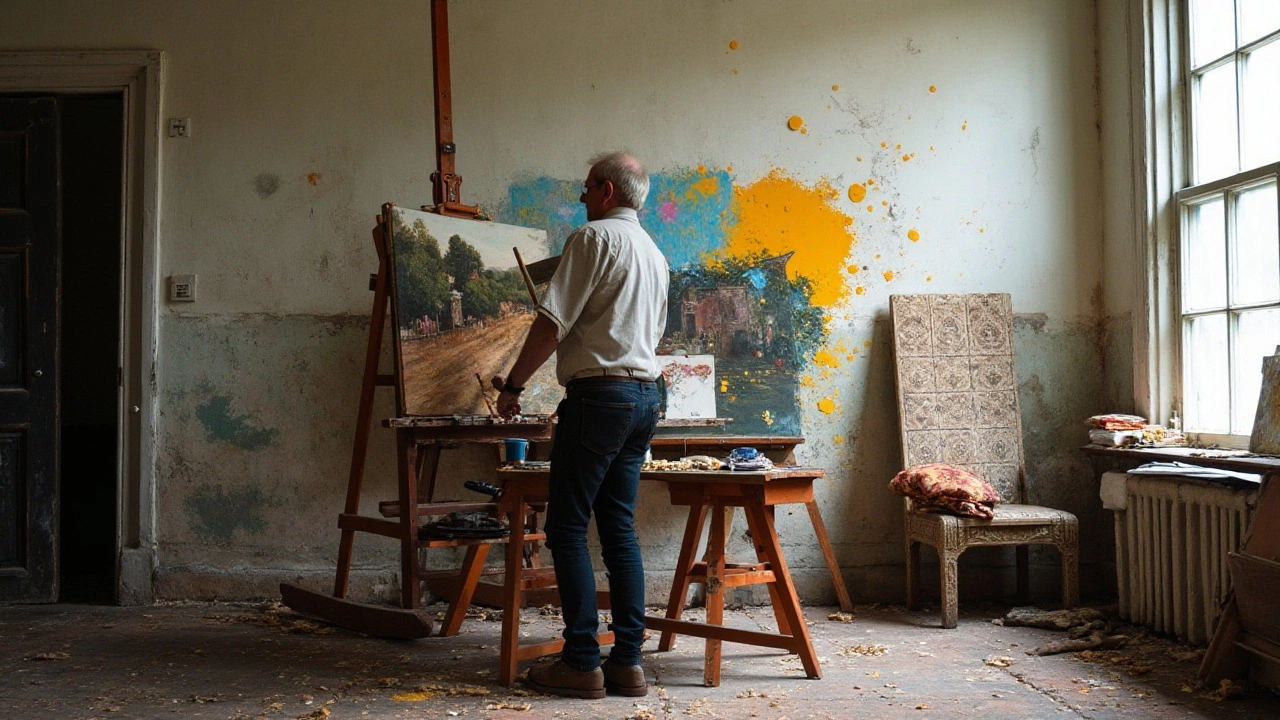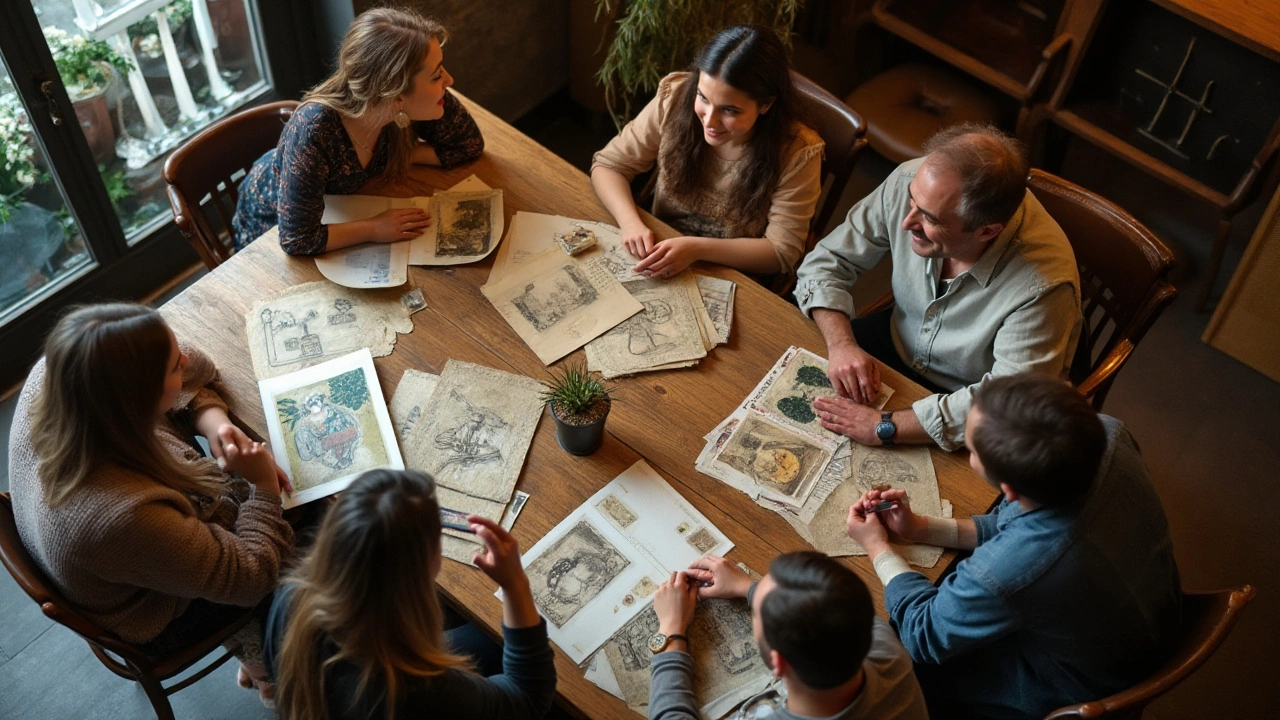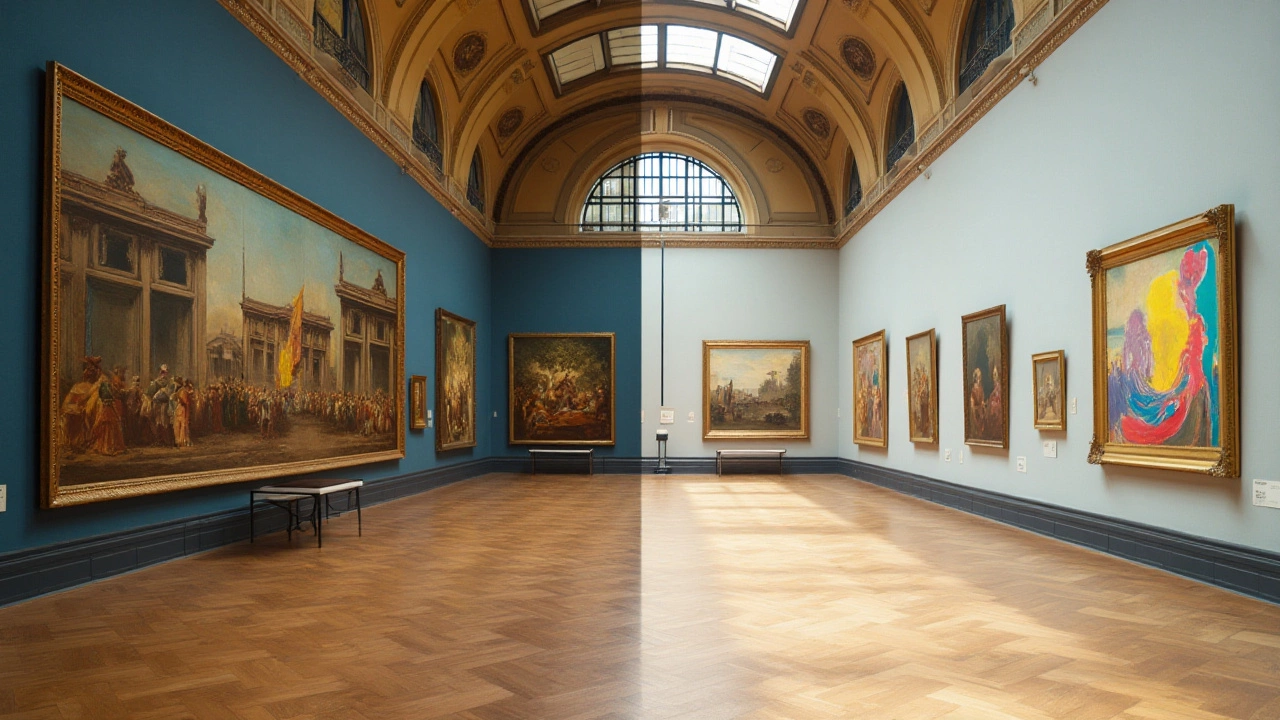In the vibrant tapestry of human creativity, modern art stands as a unique and polarizing chapter. For some, these works are mere splashes of emotion; for others, they are profound statements. This difference in perception often fuels the debate on whether modern art lacks the skill traditionally associated with classical artwork.
In previous eras, artists were frequently judged by their ability to recreate their subject with precision. Today, however, the art world has expanded its definition of 'skill' to encompass the ability to provoke thought and challenge the status quo. Join us as we delve into this exciting discourse, exploring how skill is interpreted, challenged, and even redefined within the vibrant world of modern art.
- Historical Evolution of Art Forms
- Concept vs. Technique in Modern Art
- Perception of Skill in Contemporary Works
- Famous Examples and Their Impact
- Controversy and Criticism
- Redefining Skill in Art Today
Historical Evolution of Art Forms
Understanding modern art requires us to journey back through the annals of history, where the seeds for today's artistic expressions were first sown. Art, in its earliest forms, was an amalgamation of skillful technique and cultural significance, where prehistoric cave paintings depicted the lives and beliefs of ancient peoples. These early artists, unknown yet masterful, laid down foundations that would inspire future generations to embrace the act of creation as innate to human nature.
As centuries unfolded, art began to diversify, particularly during the Renaissance, which heralded a golden age of artistic skill and innovation. Artists like Leonardo da Vinci and Michelangelo epitomized the pursuit of technical mastery, harnessing their unparalleled skills to capture minute details with awe-inspiring precision. Their works remain benchmark examples of the brilliance achievable with canvas and color, driven by a deep understanding of anatomy, perspective, and light. The Renaissance taught us that art was not merely an act of expression but also a science of observation, capturing the world's essence with remarkable accuracy.
Yet, as history propelled humanity forward, art further evolved, influenced by the social and political climates of each era. The Enlightenment period saw the rise of romanticism, where emotion triumphed over rationality, encouraging artists to delve beyond the surface and into the emotional depths of their creations. This period was crucial in highlighting the value of emotional expression, often perceived as the heart and soul of artistic endeavors. But it was not until the advent of modernism in the late 19th century that art witnessed a profound shift, challenging traditional notions of skill while forging new pathways.
Modernism marked a rebellion against previously established norms, as artists like Pablo Picasso and Henri Matisse broke away from representational forms. They embarked on journeys of abstraction, where color and shape became vehicles for a deeper exploration of life and its myriad complexities. This era questioned and often defied what 'skill' meant, moving away from realistic portrayals towards more subjective and symbolic interpretations. Artists sought not just to depict but to evoke, engaging viewers to see the world through a new lens, one where the imagination knew no bounds.
"Art is not what you see, but what you make others see." — Edgar Degas
The 20th century further ushered in an explosion of contemporary styles with movements like surrealism, abstract expressionism, and minimalism. Each challenged the status quo, discarding traditional precepts of artistry and craftsmanship. For example, surrealists like Salvador Dali celebrated the absurd and the dreamlike, while abstract expressionists such as Jackson Pollock emphasized spontaneous and dynamic gestures. These artists began to prioritize the process of creation and its emotional resonance over the final form itself.
As we reflect on the historical evolution of art forms, one sees a continuous ebb and flow between the realms of technical skill and conceptual brilliance. This dynamic interplay ensures art remains a reflection of societal progress, an ever-adapting tapestry woven with the threads of human endeavor and imagination. While many still debate the presence of skill in modern art, it is vital to acknowledge that skill itself has merely transformed, aligning with the complexities and freedoms of the modern age.
Concept vs. Technique in Modern Art
Modern art often ignites a passionate debate centered around the roles of concept and technique. Traditionally, art has been revered for the technical prowess exhibited by its creators—painters mastered detailed brushstrokes, sculptors chiseled intricate details, and illustrators captured lifelike shadows and highlights. As we transition into the modern era, the praise heaped upon these skills has morphed into a nuanced appreciation for ideation and emotion-driven creation. Modern art often emphasizes the artist's intention and the message encapsulated in the work more than the technical execution. This shift has invited criticism, with some disenchanted by what they perceive as the abandonment of skill.
In the early 20th century, movements like Dadaism and Surrealism began questioning the very foundation of what art should represent. Artists like Marcel Duchamp broke traditional boundaries, famously declaring a common urinal as art. This marked a pivotal moment where concept overshadowed technique, sparking widespread discussions. However, this is not to say that modern art lacks skill entirely. Rather, the skill often lies in craftily communicating a deeper meaning or evoking strong emotions. Technical skill has evolved from employing a brush with precision to wielding ideas with resonance.
"Art is not what you see, but what you make others see." – Edgar Degas
Tapping into this conceptual evolution, artists like Jackson Pollock, with his energetic drippings, exemplified a departure from traditional technique yet brought forth intense emotional response and a starkly avant-garde narrative. Meanwhile, artists like Pablo Picasso still wielded profound technical skill but chose to fracture and abstract reality in ways that rendered their art modern. This dichotomy of concept versus technique allows for a broader conversation not just about art itself, but about our own perceptions and values.
One might wonder if the public's displeasure with modern art stems from a lack of understanding or perhaps discomfort with redefining what is valuable in art. The beauty of modern art lies in its subjectivity and its invitation for introspection. To embrace it requires seeking meaning beyond established technique, seeing beyond the surface level. And while the debate continues, it's undeniable that this conversation enriches our appreciation and experience of art itself, prompting each of us to reflect on what it truly means to express oneself artistically in a world where change is the only constant.

Perception of Skill in Contemporary Works
When stepping into the realm of modern art, one often encounters a plethora of questions surrounding what constitutes skill. Traditionally, skill was gauged by an artist's ability to render subjects with lifelike accuracy or to master complex techniques. However, in today's eclectic art world, the perception of skill in contemporary works has shifted considerably. Joseph Kahn, a well-known art critic, emphasizes this transformation by stating, "Skill may not just be in the execution, but in the ability to evoke a response—or a debate—that lingers long after viewing." This perspective embodies the modern adage that art's true worth lies as much in intellectual provocation as in technical execution.
Consider, for instance, a Jackson Pollock painting, often a crescendo of drips and splatters. The skill inherent in these works isn't immediately about perfection or detail but rather in its chaotic beauty and its ability to lead the viewer into a deeper exploration of freedom and spontaneity. With Pollock, the act of painting becomes a performance, a dance with the canvas where skill is determined by movement, intuition, and rhythm, instead of meticulous strokes. This process challenges the viewer to rethink what they value in an artwork. Another compelling example is the artwork of Ai Weiwei, whose conceptual works often blend artistic skill with potent social and political commentary. Here, the skill is amplified by using the medium as a platform for activism, redefying the boundary between art and life.
For many, especially in educational settings, the appreciation of skill in contemporary art is cultivated through understanding the artist’s intention and the context of their work. Recognizing how artists manipulate concepts, emotions, and innovative techniques to start dialogues about pressing contemporary issues is crucial. A survey conducted in art schools across Europe discovered that 65% of students rated conceptual development and contextual understanding as more critical to evaluating modern art than technical precision alone. This data point underscores the paradigm shift that opens up a wider panorama of what is deemed skillful in art today.
However, the debate remains intense. Some purists argue that the erosion of technical skill represents a decline in the standard of art, creating a schism between traditionalists and modernists. Yet, even in this debate, there lies an opportunity to expand our understanding of art. The young and emerging artists’ boldness to question and radically widen the frame of what comprises artistry may, in fact, symbolize an evolution of skill—one that's less visible to the eye but deeply felt in the resonance of its impact. This ongoing dialogue continues to shape public perception, allowing a richer and more inclusive understanding of what skill can embody in art. As the art world continues to diversify, it is not the diminishing of skill but its redefinition that keeps it vibrant and alive.
Famous Examples and Their Impact
When discussing modern art and its perceived lack of traditional skill, certain works stand out for their provocative nature and the conversations they ignite. A prime example is Marcel Duchamp's 'Fountain', a 1917 piece that controversially presented a porcelain urinal as art. Duchamp's work was a bold statement that challenged the very foundation of what art could be, suggesting that art's value lay not in craftsmanship, but in its ability to disrupt and engage the mind. Such bold gestures questioned the entrenched art institutions and paved the way for more experimental forms.
Another significant piece is Jackson Pollock's drip paintings. Known for their chaotic energy and lack of representational figures, they broke away from conventional techniques. While some saw Pollock's technique as a lack of skill, others recognized the sheer physicality and innovation involved in creating these mesmerizing works. The impact was such that his paintings redefined the boundaries of painting as a discipline, emphasizing the process as much as the product. The work of Pollock and his peers initiated a movement towards abstraction that forever altered the artistic landscape.
"Art is not what you see, but what you make others see." – Edgar DegasAndy Warhol also left an indelible mark with his Campbell's Soup Cans. By incorporating commercial and popular cultural elements into art, Warhol questioned the elitist art world and extended art's reach. His method mirrored the burgeoning consumerist culture, making art accessible and relatable. Through his pioneering use of silkscreening, Warhol demystified artistic complexity and initiated a wider acceptance of modern, conceptual art. This democratization of art created a paradigm shift, making it more inclusive and less intimidating for the general public.
These famous examples underscore a significant shift in the art world, from a focus on skill as demonstrable technical prowess to a broader interpretation of what art can express and achieve. This change has had far-reaching implications, influencing not only the nature of contemporary art but also how it's critiqued and appreciated. While traditionalists may lament the loss of classical techniques, modern art, in its myriad forms, has fostered a more democratic art world, encouraging diverse voices and perspectives.

Controversy and Criticism
The world of modern art is nothing if not divisive. Much of the controversy surrounding it emanates from the seemingly simplistic techniques employed by some contemporary artists, which stand in stark contrast to the classical attention to detail and realism revered in older art forms. Critics often question whether the deliberate abandonment of traditional skills equates to a lack of talent or represents something deeper—a bold statement about breaking free from the chains of convention. This debate is ongoing among art enthusiasts, scholars, and the general public alike, each holding diverse interpretations of what skill truly involves in the context of today's art. With the rise of abstract and conceptual art, questions about aesthetics and technical prowess continue to stir up passionate discussions.
One of the most enduring criticisms of modern art is its perceived inaccessibility. Many viewers find it challenging to relate to or understand what they are viewing, leading them to dismiss it as lacking meaning or purpose. This sentiment is echoed in the words of renowned art critic Robert Hughes, who once remarked, "The greater the artist, the greater the doubt; perfect confidence is granted to the less talented as a consolation prize." Such statements highlight the tension modern artists face as they balance the desire to innovate against the risk of alienating their audience. Critics argue that without the ability to communicate effectively with viewers—even through abstraction—art loses its fundamental role as a medium of human expression.
Perhaps the key to understanding modern art lies in redefining what constitutes 'skill.' While prior generations celebrated precise brushwork and anatomical perfection, today's art world equally values ideas and conceptual depth. This has naturally led to contention among those who view art through a traditional lens. As Benjamin Franklin once astutely observed, "Freedom is not a gift bestowed upon us by other men, but a right that belongs to us by the laws of God and nature." The liberty with which modern artists express their distinct visions can sometimes be misinterpreted as a lack of direction, when in reality, it is a conscious choice to showcase creativity in raw and unfiltered forms.
Despite its critics, contemporary art has undeniably carved its niche. Shows across galleries worldwide attest to its compelling power and ability to evoke strong reactions. Acceptance of its unorthodox nature has fostered nuanced dialogues about cultural, political, and social issues. As the art itself pushes boundaries, it encourages viewers to question and rethink conventional norms. In this spirit, the controversy surrounding modern art does more than just challenge the traditional concepts of skill; it also serves as a monumental step toward evolving the anticipation of what art can and should be in society.
Redefining Skill in Art Today
The concept of skill in modern art stretches beyond the classical notions tied to realism and precision, resonating with a contemporary audience that values idea and essence over perfection in replication. Gone are the days when skill was exclusively gauged by an artist's ability to meticulously render their subjects. Today, the artist's ability to communicate profound truths and spark dialogue is equally prized, if not more so, by both critics and enthusiasts alike.
Modern art challenges our understanding of what it means to be skilled, invoking questions and dialogues that delve deeper than the canvas itself. It isn't unusual for contemporary artists to embrace multimedia tools, blend genres, or defy conventional methods, all in a quest to express new narratives. For instance, the work of *Yayoi Kusama*, known for her immersive and repetitive motifs, encourages viewers to experience art as an interactive journey. Similarly, the graphic boldness of *Keith Haring* conveys narratives so powerful that they occupy minds long after the viewer has left the gallery.
The Role of Concept versus Technique
Art enthusiasts and skeptics alike often debate the value of a well-conceived idea over traditional craftsmanship. In truth, this divide might seem greater than it is. The reality is that modern artists often navigate a delicate balance between concept and technique, which may involve unorthodox methods to execute their vision. Take, for example, the modern art movement's pioneers like *Jackson Pollock* who defied norms with his drip painting—the performance itself becoming part of the art."Art enables us to find ourselves and lose ourselves at the same time." – Thomas MertonConsider also artists who incorporate technology, using digital mediums or interactive installations to redefine engagement. These artists provide a broad palette upon which skill is not diminished, only diversified. The artistic prowess lies not in whether brush strokes capture life perfectly, but in whether they evoke life emotionally and intellectually for the viewer. Understanding this perspective can shift the recognition of skill from sheer technicality to poignant engagement.
Research shows that today's art market values disruptive creativity—art that challenges norms and invites introspection. According to a survey by Art Basel and UBS Global Art Market Report, *over 90% of galleries noted an increase in demand for works by contemporary artists challenging traditional borders between form and function.* This trend reflects a market eager for the avant-garde—a testament to the shifting perception of skill.
The acknowledgement of varied mediums brings along a diverse patronage, where gallery-goers seek pieces that resonate on a personal level. This era of subjective appreciation places the emphasis on connection rather than flawless craft. In this way, contemporary painting and other art forms encapsulate a living dialogue between creator and spectator, where skill is undeniably present but transformed.

